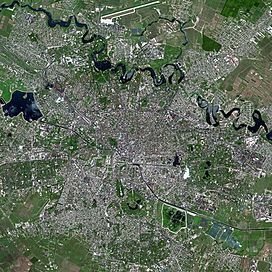Herăstrău
| Herăstrău Park | |
|---|---|
| Parcul Herăstrău | |

View from the park towards Casa Presei Libere
|
|
| Location | Bucharest, Romania |
| Coordinates | 44°28′41″N 26°04′53.1″E / 44.47806°N 26.081417°E |
| Area | 187 hectares |
| Established | 1906 |
| Administered by | Administraţia Lacuri, Parcuri şi Agrement Bucureşti |
| Status | Open all year |
| Designers | Ernest Pinard, Rebhun. Fr. Rebhun and Octav Doicescu |
| Website | herastrauparc |
Herăstrău Park (Romanian: Parcul Herăstrău) is a large park on the northern side of Bucharest, Romania, around Lake Herăstrău, one of the lakes formed by the Colentina River.
The park has an area of about 187 ha, of which 74 ha is the lake. Initially, the area was full of marshes, but these were drained between 1930 and 1935, and the park was opened in 1936. The park is divided into two zones: a rustic or natural zone (the Village Museum), which is left more or less undisturbed, and a public/'active' domain with open areas for recreation activities. Small boats are allowed on the lake.
The park was initially intended to be called Parcul Național, but it was renamed Parcul Carol II during the period of the Carol II of Romania's cult of personality. Following World War II, it was renamed Parcul I. V. Stalin, featuring a statue of Stalin at its entrance. The park was renamed and the statue was torn down in 1956 as part of the De-Stalinization in Romania.
Its current name, Herăstrău, named after the Herăstrău lake, has its origin in a dialectal version of the word ferăstrău in standard Romanian, meaning saw or sawmill, referring to the water-powered sawmills that were once found the Colentina river which flowed through it.
The area of the park has been inhabited since the Paleolithic, traces of settlements being found at the Herăstrău sand quarry, including flint tools made by the Mousterian culture, a culture generally associated with the Neanderthals. During the quaternary glaciation, the area was inhabited by large mammals such as the woolly rhinoceros and the mammoth, bones of the latter being found in the Herăstrău sand quarry.
...
Wikipedia

